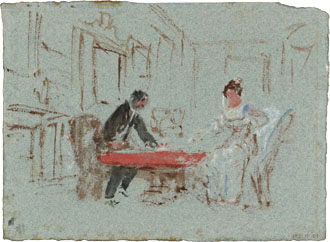|
| Magriel's NYT Columns |
 The 1977 Autumn Backgammon Tournament, sponsored by the Children’s Cancer Fund of America, was recently held at New York City’s Regency Whist Club. This distinguished event, limited to 64 contestants, always attracts some of the finest players in the country.
The 1977 Autumn Backgammon Tournament, sponsored by the Children’s Cancer Fund of America, was recently held at New York City’s Regency Whist Club. This distinguished event, limited to 64 contestants, always attracts some of the finest players in the country.
In one semifinals match, Andrew Rogacki overcame Judson Stuker; in the other, Jack Furey beat Joan Ault. In the finals, Furey took first prize, defeating Rogacki 25 to 23. Joe Pasternak won first place in the consolation tournament.
In the 25-point finals match between Rogacki and Furey, Furey held a small lead throughout. Furey reached match point, one point away from victory, with a score of 24 to 23. At this point the Crawford Rule prevented doubling in the game. (This rule, used only in tournament play, states that when one player reaches match point, no doubling is allowed in the next game.)
|
24
MATCH TO 25 23 |
| Black to play 3-1. |
Black has two possible tactics for clearing the 7-point. His first option is to break this point immediately, playing 7/4*/3, hitting White on the 4-point and moving on to the 3-point. His second option is to wait for a better opportunity and simply play 6/2.
|
|
|
By playing 6/2, Black waits, hoping to clear the bar-point later, without leaving any shots at all. However, if Black does not roll well, he may be forced to leave a direct shot, or, worse yet, a double direct shot.
6/2 is actually the correct play. The other play, although tempting, is unnecessarily risky. 6/2, on the other hand, is safer than it appears; only 6-2 and 6-3 (4 combinations) on the next roll will force Black to leave a direct shot.
Note that with either play, Black unfortunately has virtually no chance of gammoning White and thus immediately gaining the 2 points needed to win the match. Consider for example, if instead of the diagrammed position White had more men in the outfield and a gammon were a close issue, then playing 7/4*/3 might indeed be correct. By hitting White, and possibly keeping him on the bar, Black might gain the extra time needed for a gammon. In such a case the extra risk would be justified.
In the actual game Black (Rogacki) made the correct play but was not rewarded for his patience. Next turn he rolled a 6-3, forcing him to hit “loose” (unprotected) on the 4-point. White (Furey) reentered from the bar with a 4 to hit Rogacki and went on to win the game and the match.
Rollout
 Tom Keith 2013 |
|
Match to 25 White 24, Black 23 White owns 2-cube Black rolls 3-1 1296 games with VR Checker play: 2-ply Cube play: 3-ply Red |
| 3-1: | Game | G | BG | Equity | ||||
| 1 | 6/2 |
W L |
.8372 .1628 |
.2186 .0067 |
.0006 .0002 | +0.6745 |

| (b) |
| 2 | 7/4*/3 |
W L |
.7878 .2122 |
.2727 .0064 |
.0005 .0000 | +0.5757 | (0.0988) | (a) |

|
|

